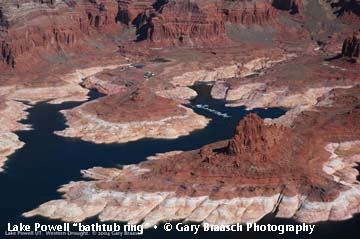U.S. Global Change Research Program summarizes climate changes in the United States in a June 2008 report.
This report, "Global Climate Change Impacts in the United States," spells out in great detail what global warming has already caused across the continental states (Alaska and Hawaii are of course included, and show how these American states are affected by important shifts in Arctic and Pacific island climates). The report is available at the government climate website.
The summary here is taken directly from the report and should dispel any doubt that the U.S. has already been changed by increasing atmospheric temperatures. The nation has a huge stake in lives, buildings, agriculture and ecosystems being damaged enormously if heat-trapping greenhouse gases are not curtailed very rapidly -- here and around the world.
1. Global warming is unequivocal and primarily human-induced.
Global temperature has increased over the past 50 years. U.S. average temperature has risen more than 2 degrees F over the past 50 years. This observed increase is due primarily to human-induced
emissions of heat-trapping gases.
2. Climate changes are underway in the United States and are projected to grow.
Climate-related changes are already observed in the United States and its coastal waters. These include increases in heavy downpours, rising temperature and sea level, rapidly retreating glaciers, thawing permafrost, lengthening growing seasons, lengthening ice-free seasons in the ocean and on lakes and rivers, earlier snowmelt, and alterations in river flows. These changes are projected to grow.
3. Widespread climate-related impacts are occurring now and are expected to increase.
Climate changes are already affecting water, energy, transportation, agriculture, ecosystems, and health. These impacts are different from region to region and will grow under projected climate change.
4. Climate change will stress water resources.
Water is an issue in every region, but the nature of the potential impacts varies. Drought, related to reduced precipitation, increased evaporation, and increased water loss from plants, is an important issue in many regions, especially in the West. Floods and water quality problems are likely to be amplified by climate change in most regions. Declines in mountain snowpack are important in the West and Alaska where snowpack provides vital natural water storage.
5. Crop and livestock production will be increasingly challenged.
Many crops show positive responses to elevated carbon dioxide and low levels of warming, but higher levels of warming often negatively affect growth and yields. Increased pests, water stress, diseases, and weather extremes will pose adaptation challenges for crop and livestock production.
6. Coastal areas are at increasing risk from sea-level rise and storm surge.
Sea-level rise and storm surge place many U.S. coastal areas at increasing risk of erosion and flooding, especially along the Atlantic and Gulf Coasts, Pacific Islands, and parts of Alaska. Energy and transportation infrastructure and other property in coastal areas are very likely to be adversely affected.
7. Risks to human health will increase.
Harmful health impacts of climate change are related to increasing heat stress, waterborne diseases, poor air quality, extreme weather events, and diseases transmitted by insects and rodents. Reduced cold stress provides some benefits. Robust public health infrastructure can reduce the potential for negative impacts.
8. Climate change will interact with many social and environmental stresses.
Climate change will combine with pollution, population growth, overuse of resources, urbanization, and other social, economic, and environmental stresses to create larger impacts than from any of these factors alone.
9. Thresholds will be crossed, leading to large changes in climate and ecosystems.
There are a variety of thresholds in the climate system and ecosystems. These thresholds determine, for example, the presence of sea ice and permafrost, and the survival of species, from fish to insect pests, with implications for society. With further climate change, the crossing of additional thresholds is expected.
10. Future climate change and its impacts depend on choices made today.
The amount and rate of future climate change depend primarily on current and future human-caused emissions of heat-trapping gases and airborne particles. Responses involve reducing emissions to limit future warming, and adapting to the changes that are unavoidable. For more on that, please see the Actions page on this website.
Pushing the Boundaries of Life: Mid-latitudes
The myriad creatures and plants with whom we share this planet are intimately tied to their habitat and zone of temperature, precipitation or ocean current. As mean temperatures rise, and climate is affected, living things have no choice but to react -- to move or adapt. On earlier pages, this Web site documents some of these changes in polar regions, where climate change is very dramatic
The same changes are at play in the mid latitudes, also. It is very clear that huge changes in biodiversity and individual creatures are happening now -- and many are accelerating.
In the past few years, scientists have published a large number of studies showing strong correlations between climate change and animal and plant range changes. The latest of these were published in the IPCC reports of 2007, based on peer-reviewed journal studies going back to January 2003 and 2004 in the journal Nature.
In one of the largest of these far-reaching peer-reviewed articles, an international group of scientists has predicted that by mid century up to a third of land plants and animal species may be pushed close to extinction. The study, "Extinction risk from climate change," measured the responses to current change and habitat limits of 1103 species in many habitats, and found that climate change is "...likely to be the greatest threat in many if not most regions." The scientists wrote that these climate effects and the damage being caused by over-grazing, over-fishing, and over-use of the planet are “strengthening the hypothesis that the natural world is experiencing the sixth major extinction event in its history.”
Nature also published an analysis of studies of more than 1,700 species indicating significant range shifts averaging 6.1 km per decade towards the poles. It reported that natural springtime events are occurring earlier by 2.3 days per decade in the late 20th century. A second analysis of 143 studies shows a significant impact of global warming is already discernible in animal and plant populations.
The IPCC review of changes to ecosystems and human habitations (see this website, section "About Global Warming") looked at over 650 studies of changes to the Earth and its inhabitants, which included 29,436 sets of long-term observations. They confirmed that effects of temperature increases are pervasive across the globe and that, in the words of Cynthia Rosenzweig, a NASA scientist who took part, “the changes have intensified.” They tallied ongoing habitat changes, landscape alterations, and loss of
biodiversity on every continent.
As changes proceed, many species will be able to shift their range or alter their behavior in response, and that is already leading to shifts in diseases, loss of agricultural production, and ecosystem alterations that affect human life. But some, perhaps many, species will
be blocked because they’ve run out of mountain or island, because potentially suitable habitat has been
destroyed, or because they can’t move fast enough. What will become of the familiar habitat associations
of Earth or the biodiversity and genetic flexibility they contain?
Unfortunately, ecosystems are unlikely to stay intact. “Communities of species do not move together,”
according to conservation biologist Thomas Lovejoy. “[Species] move individually at different
rates and in different directions.” As climate change intensifies, the life zones and ecological
associations familiar to us from introductory biology courses, represented by multicolored bands
splashed across world maps, are not going to move in synchrony. Rather, they will deform unevenly as
the plants and animals within them react in varying ways. No less than the ice shelves of Antarctica and
the permafrost of the Arctic, ecosystems worldwide are rending and disintegrating. With this, the rich
biodiversity of Earth, the flow of life that humans rely on, is threatened.
See my Reference section for details of some of these studies. Also Chapter 3 of Earth Under Fire has much more detail and a description of changes occurring in national parks and protected areas. Photos of some plant and animal reactions in the temperate zone are the subject of this portion of World View of Global Warming..
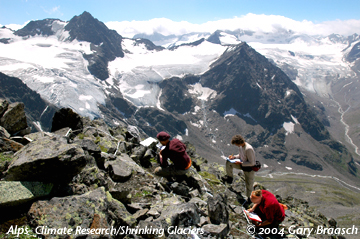
Alpine meadow and fell-field ecosystems are changing under atmospheric warming. On this site at 3000 meters in the Austrian Alps, Botanist Harald Pauli and researchers are finding plant species increasing and decreasing at different rates over a 10 year period. Essentially, the familiar alpine wildflower fields are being fragmented and rearranged. This is especially dangerous for plants forced to move upwards where there is just rock and ice, says Pauli. "We are running into a really serious loss of biodiversity." The 380 sites here were established in 1994 by Georg Grabherr, Pauli and others at the University of Vienna. This alpine research idea has expanded world wide into GLORIA - the "Global Observation Research Initiative in Alpine Environments."
The glaciers behind the scientists are an even more visible sign of global warming.
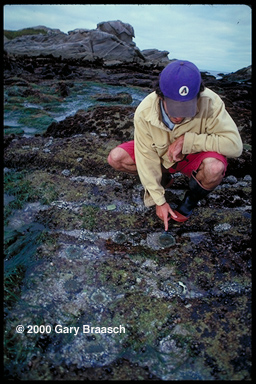

Marine Biologist Rafe Sagarin points out some of the tide pool habitat that was found to have changed when he re-inventoried a 60-year-old study at Hopkins Marine Laboratory, Monterey California. Summer sea temperature has risen more than one degree in that time, and the re-survey showed many warm water tidepool animals had increased while those favoring colder water had decreased.
This nudibranch Hopkinsia rosea, discovered at and named for the Hopkins Lab, was numerous in the 1930s survey but not seen at all 60 years later. It is still found in other locations near Monterey, favoring cooler water. Other species, such as predatory snails and anemones showed great shifts in those thriving in warmer water south on the California coast.
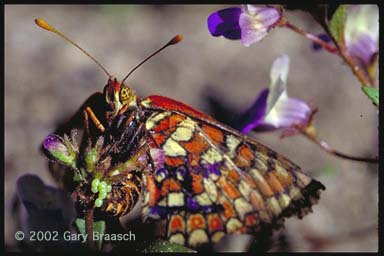
Biologist Camille Parmesan compared old records of the Edith’s checkerspot butterfly against current habitat from Mexico to Canada and found that the insect had moved its habitat slightly north in response to climate warming. She found the level of population extinctions is four times as high at the far southern end of the range (Mexico) than at the northern. This change in a sensitive insect was predicted from the twentieth century warming of about 1 degree F.
The butterfly pictured is laying eggs on Collinsia, an annual plant of Sierra Nevada high meadows. Annual plants are more affected by weather shifts, and this is one of the factors in the butterfly population shifting as climate changes the habitat of both animals and their host plants.
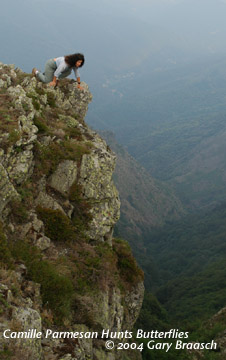
Dr. Parmesan later collaborated with many European biologists and lepidopterists to show that 2/3 of butterfly species with long observational records had shifted northward by from 22 to 150 miles, consistent with temperature increases in Europe. No butterflies were found to have shifted to the south. Parmesan has found many locations in Southern France with apparently intact food-plant habitat that no longer have well known butterflies like the Apollo (Parnassius apollo)..
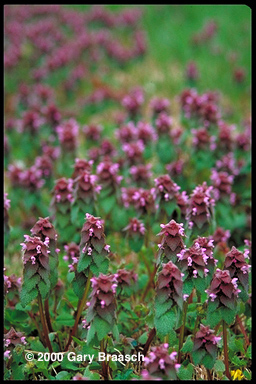
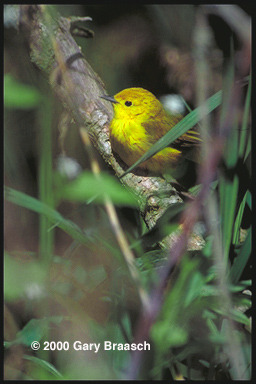
Throughout the temperate zone, changes are being recorded in where and when plants bloom and thrive. One recent study by botanists at the Smithsonian's National Museum of Natural History reviewed records on the spring bloom time of 100 common Washington D.C. area plants. Eighty-nine of the 100 showed significantly earlier blooming. This one, the common lawn weed deadnettle, photographed at the National Arboretum, is blooming an average of 39 days earlier than in 1970.
American ornithologists are investigating climate change in several ways. Jeff Price of the American Birding Congress collects data from birders and scientists and reports changing migration and ranges for hundreds of North American species. This yellow warbler was an early migrant at Point Pelee National Park, Ontario.
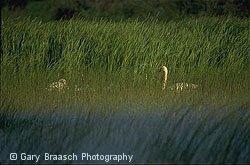

Meanwhile Terry Root of Michgan University correlated regional temperatures with a 50 year record of bird arrival at Seney National Wildlife Refuge, Michigan. Comparing yearly records kept by now-retired field biologist Elizabeth Losey with current arrival times showed significantly early in-migration.
Even though the predicted range of climate warming has just begun, many ecologial responses are already clearly visible, as seen in these and other studies. Recent scientific reviews of biologial research show that strong effects are being seen in habitats from alpine meadows to coral reefs, and from the tropics to the poles.
Among the important review articles are Gian-Reto Walther et al., "Ecological responses to recent climate change." Nature 416 (28 March 2002), and Drew Harvell et al., "Climate Warming and Disease Risks for Terrestrial and Marine Biota," Science 296 (Jun 31 2002). World View of Global Warming will be documenting some of these studies in the coming months
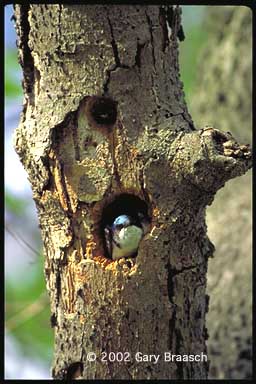
Tree swallow Tachycineta bicolor in nest hole at Point Pelee, Ontario
Another study showed the egg laying date of North American tree swallows advanced by up to nine days during the period from 1959 to 1991. Reported in 1999 by Peter O. Dunn, Univ. of Wisconsin and David W. Winkler, Cornell Univ, the research correlated 3450 nest records, taking into account differences of location, elevation and other breeding factors. "WE conclude," wrote the scientists, "that tree swallows across North America are breeding earlier and that the most likely cause is a long term increase in spring temperature."
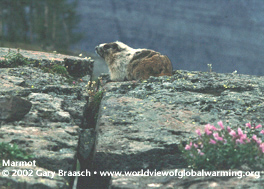
Mountains are undergoing some of the most crucial changes due to global warming. Besides the loss of glaciers, warming temperatures are driving the alpine zones farther up toward the summits. Eventually, the highest alpine plants and animals will have nowhere to go. This effect is being seen in and near Rocky Mountain National Park, where marmots are coming out of hibernation earlier, and in Great Basin mountains where some populations of pikas have disappeared apparently due to climate changes.
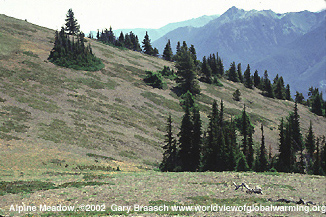
Other research is focused on alpine trees and meadows, showing that mountain hemlocks and sub alpine firs are moving into meadow areas in Mt Rainier and Olympic National Parks -- and the effect is expected to accelerate if temperatures continue to rise rapidly. In Yellowstone National Park, the zone of life for the whitebark pine is moving up toward the summit of the mountains. If this reduces the number of these pines, it will affect not merely scenery, because the seeds of the whitebark are a crucial part of grizzly bear diet.
"Sez who?": References 4
Each of the foregoing photos reports on documented science, peer-reviewed published studies and scientific literature surveys. Those references are listed later in this Web site, along with climate change data, World View of Global Warming project advisors, and links to some sources of climate information.
COPYRIGHT NOTICE:
Photography and text Copyright © 2005 - 2017 (and before) Gary Braasch All rights reserved. Use of photographs in any manner without permission is prohibited by US copyright law. Photography is available for license to publications and other uses. Please contact requestinformation@worldviewofglobalwarming.org. View more of Gary Braasch's photography here.



